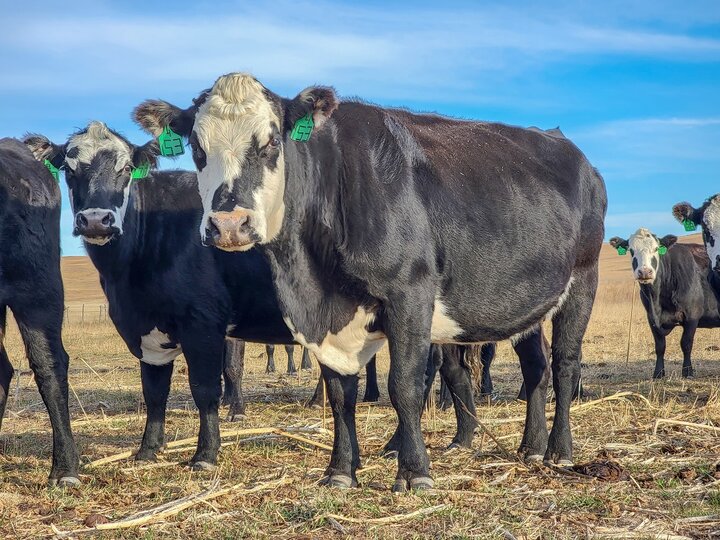It's April and for cow/calf producers in the Northern Great Plains the majority of the cows are calving or are about to start calving. Cow/calf producers during this time period are typically feeding harvested forages. A frequent question from producers is "how much will my cows eat on a daily basis"? Producers want to meet the cows' nutrient requirement, but sure don't want to over-feed expensive forages. With the dry conditions this past summer and harvested forages at a premium, closely estimating the amount of feed needed to get through the winter and early spring will be important to contain cost.
The Difference Between Intake on a Dry Matter and As Is Basis
This can be a challenging concept to explain – what the difference between dry matter and as-fed – especially when nutriments for beef cows are on a dry matter basis. Intake on a dry matter basis means that the forage doesn't include moisture. However, we know that the forages contain moisture and not all forages contain the same amount of moisture. So if forage intake can be determined on a dry matter basis, it can easily be converted to an "as is" or "as-fed" basis.
As an example, if it were determined the daily dry matter intake of a group of 1,200 pound cow eating an average quality hay is 24 pounds per head and the hay that they are consuming is 88% dry matter, these cows would consume about 27 (24 pounds/.88) pounds per head per day on an as-fed basis.
If the same group of 1,200 pound cows are fed a ration where part of the ration called for corn silage to be fed at 10 pounds per head per day on a dry matter basis and the corn silage is 35% dry matter and 65% moisture, the pounds of corn silage in the diet would be 28.5 (10 pounds/.35) pounds per head per day on an as-fed basis. Remember that of the 28.5 pounds of silage, 18.5 pounds is water and 10 pounds is silage.
What Determines Daily Forage Intake
There are a number of different factors that determine the daily intake of a cow. The primary factors are cow weight, forage quality, and stage of production (gestating or lactating). When feeding the same forage, cows that weigh 1,300 pounds will consume more on a daily basis compared to lighter weight cows that weigh 1,100 pounds. In addition, cows that are lactating will consume more feed than cows that are not lactating.
Forage quality impacts dry matter intake of cows. As the forage quality increases, indicated as an increase in TDN content of the forage, the amount of the forage that the cow can consume also increases. As forage quality increases, there is more leaf as compared to stem. When quality is low, there is more stem, therefore more cell wall contents that are not as easily digested - the forage does not pass through the rumen very fast.
In addition, as forages increase in maturity, there is an increase in lignin content. Lignin is not digested by the rumen microbes.
A good example of how forage quality impacts the amount a cow can consume daily is wheat straw. Wheat straw is low in protein and energy, 4.0% crude protein and 40% TDN. When cows have full access to wheat straw, they don't quit eating wheat straw because they don't like it, they quit eating it because they can't stuff anymore into their rumen. Straw has such a low digestibility that it takes extra time in the rumen for it to be digested and passed through the rumen before more can be consumed. Daily intake on a dry matter basis may be 1.6% to 1.8% of her body weight. In comparison, corn silage will typically be about 70% TDN and lactating beef cows can easily consume 2.5% to 2.7% of their body weight on a dry matter basis of this feed.
There are some "thumb rules" to help estimate daily feed intake of cows on a dry matter basis consuming forages of differing quality when they are either gestating or lactating.
- When forage quality is low (52% TDN or less) and cows are not lactating, they will consume 1.8% and lactating cows about 2.0% of their weight on a dry matter basis.
- If the forage quality is average (TDN content between 52% and 59%), non-lactating cows will consume about 2.0% to 2.1.% and lactating cows about 2.3% of their body weight daily on a dry matter basis of this forage.
As an example, if the forage were 55% TDN and lactating cows on the average weigh 1,200 pounds, then it could be estimated that they would eat 28 (1200 pounds x 0.023) pounds of hay daily on a dry matter basis. If the hay were 88% dry matter, on an "as-fed" basis, cows would eat about 32 (28 pounds/.88) pounds daily. If there were 200 head of cows in the herd, it would take about 3.2 ton of this hay per day [(200 head x 32 lb/hd/da)/2000lb] not accounting for any waste.
Estimating daily feed intake of your cow herd is the first step in determining the amount of forage that is needed to be on-hand for a harvested forage feeding program. When forage availability is tight like it is during drought, being able to determine how much inventory needed will help enhance the profit potential of the cow/calf enterprise.

